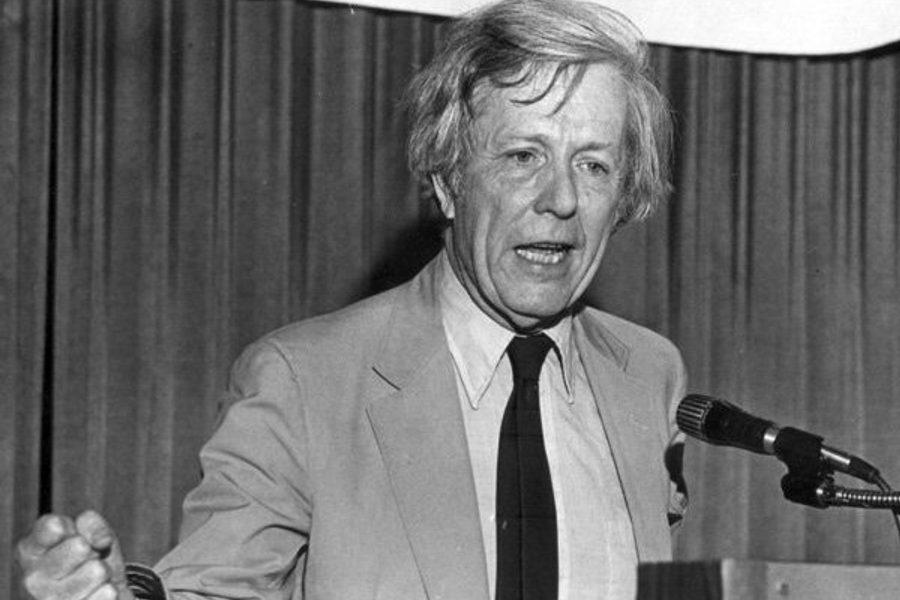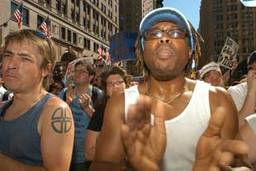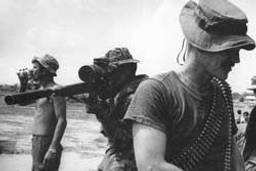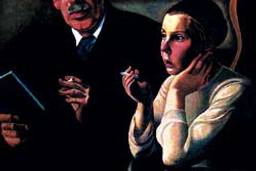On Michael Harrington’s Democratic Socialism
Maurice Isserman’s biography of Harrington depicts a fierce lifelong advocate for democratic socialism who butted heads with the New Left but never wavered in his commitment to economic justice.
Kim Phillips-Fein

From the July 2000 issue of In These Times:
When Michael Harrington worked in the Catholic Worker movement as a 23- year-old in the early ’50s, young staffers used to joke that they were in pursuit of sainthood. Harrington came close; near the end of his life, he became “a kind of secular Saint Francis of Assisi,” in the words of his biographer, Maurice Isserman. But Harrington never grew accustomed to sainthood, even the secular variety.
His position as a lone voice of conscience speaking out against Reaganism reminded him of how irritated his mentor, Norman Thomas, had been in the position of “a socialist who threatened no one and nothing … who could be revered on ceremonial occasions and cited to prove the country was genuinely tolerant and democratic.” Assessing his own life, Harrington worried that he would be remembered only as “a lesser Norman Thomas.” It was a prescient, if damning, bit of self-analysis. At the end of his new biography of Harrington, The Other American, Isserman concludes that this characterization was, unfortunately, just about right.
Michael Harrington — author of The Other America and founder of Democratic Socialists of America — makes a perplexing biographical subject. He may have been “the heir to Eugene Debs and Norman Thomas as America’s foremost socialist,” but only long after the Socialist Party had ceased to have any influence on national affairs. He opposed Communism in the ’50s, and in the ’60s he did not support the anti-war movement. He never held a position of influence in any large institution. The Other America is a moving book, but Harrington’s reputation as “the man who discovered poverty” is wildly overrated, and his actual influence on the War on Poverty legislation was negligible. Even Isserman’s opening quote — from the E.M. Forster novel Howard’s End — suggests the difficulty of writing about someone like Harrington: “With infinite effort we nerve ourselves for a crisis that never comes.”
Yet The Other American is more than a well-written biography or an elegant, balanced study of the hidden recesses of the postwar American left, though it is both these things. It is, in fact, as much a plea for a certain kind of left politics as it is a history book. What Harrington represents to Isserman is the “other” American left: anti-Communist, friendly to liberals, sympathetic to religion, willing to work within the system, nose turned up at the extremism of SDS. Isserman is not romantic about Harrington. The biography is remarkably even-handed, and offers a good account of Harrington’s failures as well as his successes. But Harrington’s life is of interest to Isserman primarily because it seems to represent a (mostly) usable past for what remains of the left today.
Michael Harrington was born in St. Louis in 1928, the only child of an Irish Catholic lawyer. An academic golden boy, Harrington was nonetheless restless and uncertain about what to do with his life. He entered law school at Yale but dropped out after one year. He flirted with a doctorate in English at the University of Chicago, but quit to move to Greenwich Village and drink at the White Horse Tavern. His career only began to take shape when he joined the Catholic Worker, where he produced book reviews and editorials at a rate that astounded even Dorothy Day.
Even before he joined the Catholic Worker, the Church had instilled in Harrington a passionately moral approach to the world. “From the time I was a little kid the Church said your life is not something you are supposed to fritter away; your life is in trust to something more important than yourself,” he would say in later life. His writing for the Catholic Worker reflected this moral, not Marxist, approach to social problems: “To view … poverty as a force in a historic [dialectic], is not only the dehumanization of the poor, it is the dehumanization of him who thinks it. The reaction to this poverty should be partly one of calculation, of how can it be eradicated, but it must also be of the Beatitudes, of hunger and thirst for Justice, of love and grief for what goes on before our eyes.”
Despite its influence on his worldview, Harrington’s spiritual faith wavered throughout his time at the Catholic Worker. When he left, Day asked him, anxiously, “Is it a woman?” (She had good reason to be concerned — Harrington’s youthful womanizing is a dark thread running through the first half of the book.) No, Harrington responded, “it’s theology.” But after leaving the Catholic Worker, he joined an organization more doctrinaire than the Church: the Young People’s Socialist League. Originally part of the Socialist Party, Trotskyists took YPSL over in the late ’30s. After several more internal splits, its last fragments went under the control of sectarian raconteur Max Shachtman, who would be one of Harrington’s mentors for the rest of his life.
In many respects, Isserman writes, the Shachtmanites were identical to “the myriad of tiny radical sects that preceded or followed them into oblivion.” But unlike the Trotskyists, they did not see the Soviet Union as a “degenerate workers’ state,” but as a society run by a new “bureaucratic collectivist” ruling class — in other words, not really socialist at all. The sect’s rhetoric was one of “stern confidence: ‘history,’ ‘the masses,’ ‘the tasks of the moment’ and so forth.” But “this was a party founded on doubt, rather than on certainty.” Though this meant constant infighting, it also made for a combative intellectual environment, a kind of think tank boot camp. It’s no wonder that so many labor politicos and academics — Deborah Meier, Peter Novick, Sandra Feldman — cut their teeth in groups orbiting the Floral Park, Long Island hi-fi dealer.
Obsessive anti-Stalinism held the Shachtmanites together. A reader of Labor Action (the Shachtmanite paper) once observed that “the word Stalin and its derivatives” appeared 114 times in a single issue. Isserman tries hard to show that Harrington was not a stooge for Joe McCarthy. He criticized Sidney Hook and the Congress for Cultural Freedom, calling it “less an organization devoted to the defense of cultural freedom than an agency propagandizing the American party line.” He never took money from the CIA. But there’s no doubt that for all their sectarian insanity, on some level the Shachtmanites were actually within the liberal consensus of the ’50s: They agreed that the Communist Party and the Soviet Union were the commanding threats to human freedom.
The anti-Stalinist left sought allies among liberals and advocated downright reformist policies — not that anyone noticed. Much of The Other American is absorbed in detailing the political zig-zags of an organization with a couple of hundred members nationwide, which held symposia on topics the proper forum for which is a late-night bull session. (For example, if a “genuinely” socialist country had nuclear bombs, should it ever use them?) At first glance, the pragmatism of the Shachtmanites seems more ludicrous than any revolutionary rhetoric. But Isserman suggests that because the Shachtmanites were willing to work with liberal politicians, in a very odd way they were oriented toward real political change in a manner that the New Left was not.
By the late ’50s, Shachtman came out in favor of “realigning” progressive forces behind the Democratic Party. Harrington initially ignored his teacher, and wrote in Norman Thomas for president in the 1960 election — something he later regretted as “one of the remarkably stupid actions of my political life.” For the rest of his days, his main political project would be the struggle to reshape the Democratic Party into a coalition of labor, civil rights organizations and liberal groups.
Harrington’s pragmatism led him to write The Other America without mentioning the word “socialist” once. (He agonized about leaving it out.) It’s an overstatement to say The Other America “started” the War on Poverty; the expansion of the American welfare state in the ’60s was just one aspect of a postwar economic policy that generally protected unions, increased wages and maintained full employment. While Harrington was a member of the president’s task force in the War Against Poverty, by most accounts he played a minimal role in Grafting the anti-poverty programs. (Dubbed “the only responsible radical in America” by Arthur Schlesinger Jr., he lived up to the description by signing his memos, “Of course, there is no real solution to the problem of poverty until we abolish the capitalist system.”) The Other America, however, with its vivid descriptions of Harlem and Appalachia, of “urban hillbillies” and the terrible plight of the aging poor, unwittingly became the best piece of public relations for the War on Poverty the Johnson administration could have asked for.
Harrington’s roots in the anti-Stalinist left encouraged him to make alliances with liberals, but they put him at loggerheads with the New Left. Throughout the ’60s, Harrington was best known in certain circles for locking out the fledgling SDS (descended from the League for Industrial Democracy, a Socialist Party offshoot) from its offices because the Port Huron statement was insufficiently anti-Communist. Though Harrington apologized for the incident for the rest of his life it’s not really surprising that it happened. Unafraid of Communist domination, the New Left saw little reason to work with mainstream politicians. SDS president Paul Potters’ 1965 description of Tom Hayden was apropos for the whole movement: “Tom seems to be moving closer and closer to a position that the liberal establishment (if not all liberals) constitutes the most dangerous enemy we confront.”
The split deepened during the Vietnam War, when Harrington failed to support the anti-war movement, thinking it too sympathetic to the Viet Cong. Isserman is careful to note that Harrington was always a pacifist and never supported the war. When Shachtman explicitly came out in favor of the war in the early ’70s, Harrington finally broke with him. But if he wasn’t in favor of the war, he was certainly opposed to the anti-war movement. Harrington’s anti-Stalinist socialism — like Cold War liberalism itself — was consumed by its own contradictions in the Vietnam War.
To Isserman, Harrington’s failure to work with the New Left approaches tragedy. “Michael let pass the chance of a lifetime to make a democratic socialist perspective relevant to the hundreds of thousands of Americans who supported the anti-war movement,” he writes. “The Vietnam War destroyed the Socialist Party, and with it Michael’s chance to reshape and reinvigorate the entire democratic left in America.”
Harrington’s relentless focus on economic issues, his moral seriousness, his “visionary gradualism,” his “pragmatic radicalism,” represent, to Isserman, the road not taken for the American left. If only the old Socialists had been able to take charge of the anti-war movement, convincing the kids to trade their Molotov cocktails for delegates’ passes, perhaps the left would not be as marginalized as it is today. If only the New Left had followed Harrington into the Democratic Party, maybe Reagan would not have won in 1980 and history would not yet be at an end.
It’s hard to know what to make of a biography of someone whose primary interest is that he represents what did not happen. Undeniably, there’s something appealing about Harrington’s politics, especially compared to the craziness of the New Left in the late ’60s. Although the Socialist Party was a mere shell of its former self throughout his lifetime, in a sense Harrington really did embody the Socialist tradition in American politics. He rejected a transcendent, Utopian leftism, believing that modern radicals had to “walk a perilous tightrope,” on the one hand to “be true to the Socialist vision of a new society,” and on the other “bring that vision into contact with the actual movements fighting not to transform the system, but to gain some little increment of dignity or even just a piece of bread.”
Like Debs, he eschewed direct action, believing that to “change the consciousness of a nation, one had to be prepared to build an organization, start a publication, speak in a thousand halls to crowds of hundreds, or scores, or tens, if necessary, recruiting one’s followers from those converted by the sound of one’s voice and the strength of one’s arguments.” This kind of slow, patient mass organizing and institution-building is precisely what the New Left failed to accomplish, and it’s not hard to understand why Isserman admires Harrington for at least recognizing its importance.
But does it make sense to ask whether Harrington’s efforts to “realign” the Democratic Party could have succeeded if the New Left had fallen into line? It’s hard to say. There were, after all, real obstacles to reforming the Democratic Party in the ’60s and ’70s. The moral absolutism of the New Left was partly youthful naivete and “revolutionary posturing.” But it also reflected a genuine sense of how compromised the liberal consensus was, and how important the segregated South was to the Democratic Party. The New Left’s alienation from the Democratic Party reflected the ambiguous nature of the institution itself: the party of labor and of the Solid South, of the War on Poverty and the Bay of Pigs.
There’s something oddly rigid — if one wanted to rib him, one might almost say sectarian — about Isserman’s implicit criticism of the radical style of the New Left. A truly “realistic” approach to politics would recognize that there are times when it’s appropriate for the left to work with the Democrats or other liberals, and there are other times, as at the height of the Vietnam War, when that’s a terrible mistake. “Militant moderation” always seems more reasonable, but there are times when it’s completely off the wall. Pragmatism makes sense when you have a fighting chance of exercising political power; otherwise, it’s as self-deluded as dreams of world revolution. As Michael Harrington knew too well, in politics, as in history, there is no room for saints.







